Discover 25 hidden attractions, cool sights, and unusual things to do in Albania. Don't miss out on these must-see attractions: National History Museum (Tirana), Skanderbeg Square (Tirana) or Clock Tower (Tirana).
Below, you can find the list of the most amazing places you should visit in Albania.
Table of Contents
National History Museum, Tirana
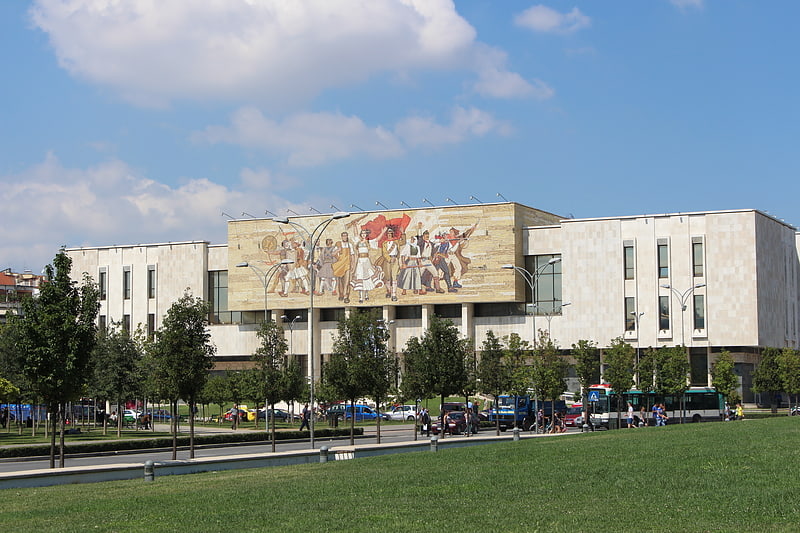
Also known as: Muzeu Historik Kombëtar
Large museum for Albanian history. The National History Museum is a historical museum in Tirana, Albania. It was opened on 28 October 1981 and is 27,000 square metres in size, while 18,000 square metres are available for expositions.
Above the entrance of the museum is a large mural mosaic titled The Albanians that depicts purported ancient to modern figures from Albania's history. The museum includes the following pavilions: the Pavilion of Antiquity, Middle Ages, Renaissance, Independence, Iconography, National Liberation Antifascist War, Communist Terror, and Mother Teresa.[1]
Address: Sheshi Skënderbej 1, 1000 Tirana
Skanderbeg Square, Tirana

Also known as: Sheshi Skënderbej
Tourist attraction in Tirana, Albania. The Skanderbeg Square is the main plaza in the centre of Tirana, Albania. The square is named after the Albanian national hero Gjergj Kastrioti Skënderbeu. The total area is about 40,000 square metres. The Skanderbeg Monument dominates the square.
The city plan for Tirana was initially designed by Armando Brasini in 1925 and continued by Florestano Di Fausto in a Neo-Renaissance style with articulate angular solutions and giant order fascias. Following the Italian invasion of Albania the master plan was updated in 1939 by Gherardo Bosio.
Many buildings including the Tirana International Hotel, the Palace of Culture, the National Opera, the National Library, the National Bank, the Ethem Bey Mosque, the Clock Tower, the City Hall, the Ministry of Infrastructure, the Ministry of Agriculture, the Ministry of Economy, the Ministry of Energy, and the National Historical Museum are situated at the square.[2]
Address: Sheshi Skënderbeu, Tirana
Clock Tower, Tirana
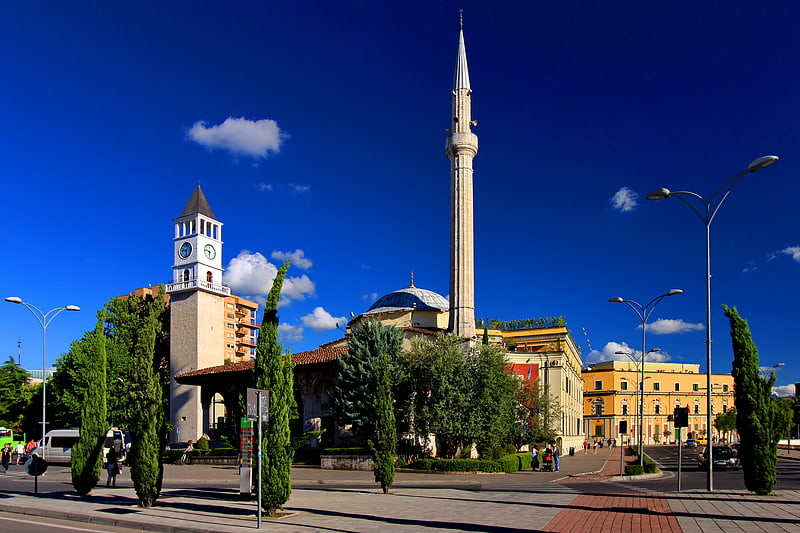
Also known as: Kulla e Sahatit e Tiranës
The Clock Tower of Tirana, was built in 1822 in Tirana, Albania by Etëhem Bey Mollaj, a Bejtexhinj poet who also finished the Et'hem Bey Mosque next to the clock tower. Watchmaster Ismail Tufina was the first to assemble the Tirana clock mechanism in 1822. It is a monument of culture of first category, approved on 24 May 1948.
The stairs have 90 steps that go in a spiral fashion. It is 35 metres (115 ft) tall and was the tallest building in the city at the time. Since the restoration of 2016, 9,833 visitors were counted, who have visited the tower. The installation of the clock was done by the renowned Tufina watchmakers. The Tufina's took care of the clock from 1822 until 1973 when forcefully removed by the communist regime.[3]
Blue Eye, Sarandë

Also known as: Syri i Kaltër
Nature preserve in Albania. The "Blue Eye" is a water spring and natural phenomenon occurring near the village of Muzinë in Finiq municipality, southern Albania. A popular tourist attraction, the clear blue water of the river can be seen from a depth of more than fifty metres. Divers have descended to fifty metres, but it is still unclear what the actual depth of the karst hole is.
This phenomenon is also known as 'springs of Bistricë' as it is the initial water source of Bistricë river, 25 km long, which ends in the Ionian Sea south of Sarandë. The source stands at an altitude of 152 m and has a discharge rate of 18400 l/s.
The immediate area 1.8 km2 (0.69 sq mi) is a Nature Monument and is characterized by oak and sycamore trees. In summer 2004, the source was temporarily dried up.
In the summer of 2017 part of the location was burnt by wildfire.[4]
Amphitheater, Durrës
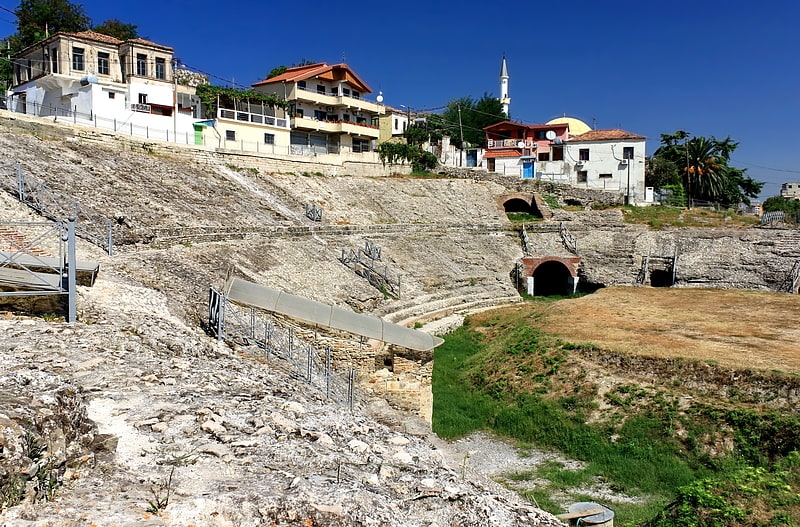
Also known as: Amfiteatri i Durrësit
Remains of a Roman amphitheater. The Amphitheatre of Durrës is a Roman amphitheatre in the centre of the city of Durrës, Albania. Construction began under the emperor Trajan in the 2nd century AD and it was destroyed twice by earthquakes in the 6th and 10th centuries. It is the largest amphitheatre ever built in the Balkan Peninsula with once having a capacity of 20,000 people.
The amphitheatre is included on the tentative list of Albania for inscribing it as a UNESCO World Heritage Site. It was discovered in late 1966 and has become a popular tourist attraction.[5]
Address: Rruga Kalase, Durrës
Gjirokastër Castle, Gjirokastër
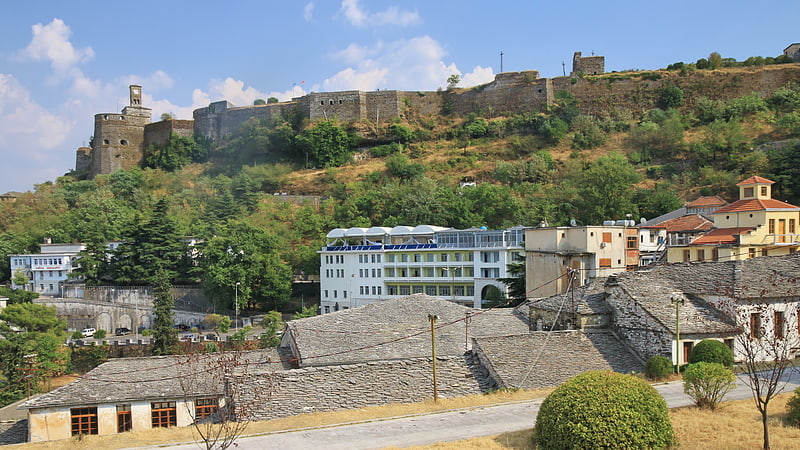
Also known as: Kalaja e Gjirokastrës
12th-century fortress and military museum. Gjirokastër Castle is a fortress in Gjirokastër, Albania. Gjirokastër Castle is situated at a height of 336 metres.
The castle dominates the town and overlooks the strategically important route along the river valley. It is open to visitors and contains a military museum featuring captured artillery and memorabilia of the Communist resistance against German occupation, as well as a captured United States Air Force plane to commemorate the Communist regime's struggle against the imperialist western powers.[6]
Address: Rruga Evlia Celebi 1, Gjirokastër
Rozafa Castle, Shkodra

Also known as: Kalaja e Rozafës
Ruins of a Venetian castle on a hill. Rozafa Castle, also known as the Shkodër Castle is a castle near the city of Shkodër, in northwestern Albania. It rises imposingly on a rocky hill, 130 metres above sea level, surrounded by the Buna and Drin rivers. Shkodër is the seat of Shkodër County, and is one of Albania's oldest and most historic towns, as well as an important cultural and economic centre.[7]
Address: Rruga Rozafa, Shkodra
Durrës Castle, Durrës
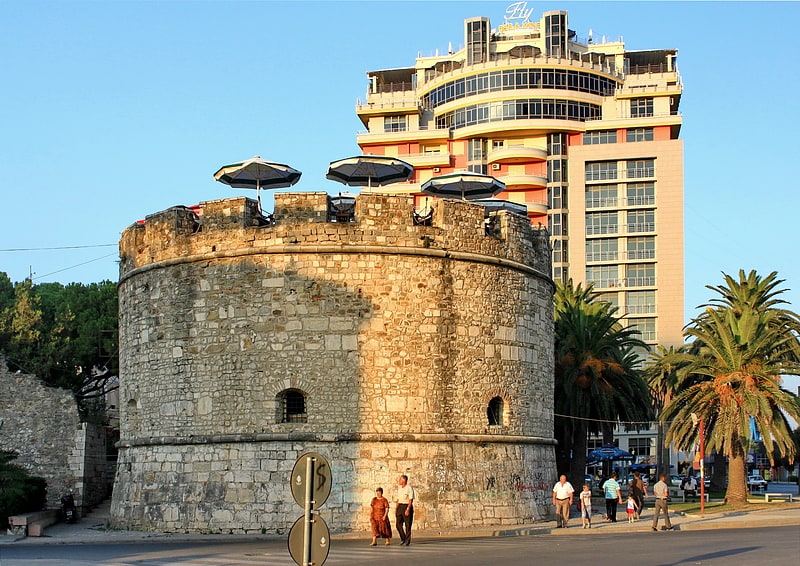
Also known as: Kalaja e Durrësit
Castle in Durrës. Durrës Castle is the fortified old city of Durrës, Albania. It is enclosed by city walls built in the late 5th century, and repaired and reinforced in the Middle Ages and early modern periods.[8]
Address: Rruga "Skenderbeg", Durrës
Skanderbeg Museum, Kruje
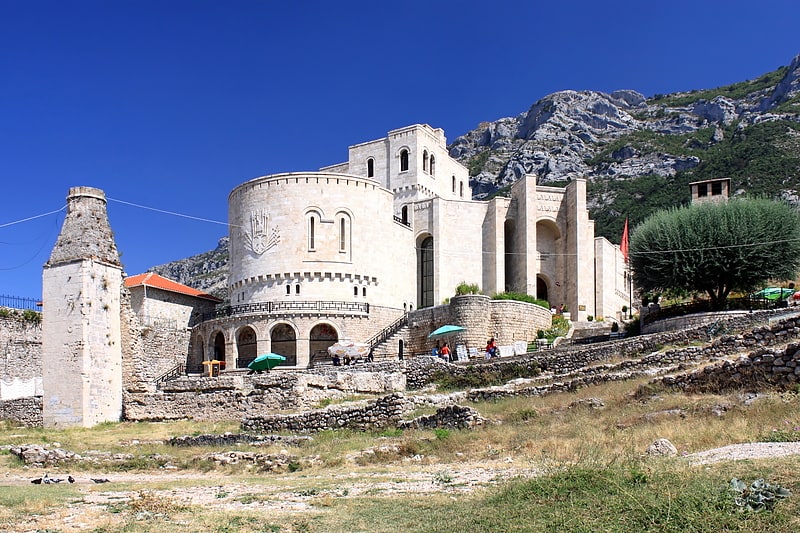
Also known as: Muzeu Kombëtar Gjergj Kastrioti Skënderbeu
Museum in Krujë, Albania. The National Museum "George Castrioti Skanderbeg", also known as the Skanderbeg Museum or the Kruja Museum, is located in Krujë and is one of the most important and visited museums in Albania. The museum was built at the end of the 70's and was inaugurated on November 1, 1982. Its architecture was designed by architects Pirro Vaso and Pranvera Hoxha. Construction works were realized by a local team managed by Robert Kote. The museum has the character of a memorial, architecturally inspired by traditional Albanian stone towers and medieval Romanesque architecture. The name of the museum is in the honor of the Albanian national hero Gjergj Kastrioti Skënderbej.
The Krujë Castle, which houses the museum, is a historic citadel. Ottoman troops attacked it thrice, in 1450, 1466 and 1467, but failed to take control. It was this impregnable fortress that helped George Kastrioti Skanderbeg defend Albania from the Ottoman invasion for more than two decades.[9]
Address: Rruga Kala, 1501 Kruje
Lëkurësi Castle, Sarandë
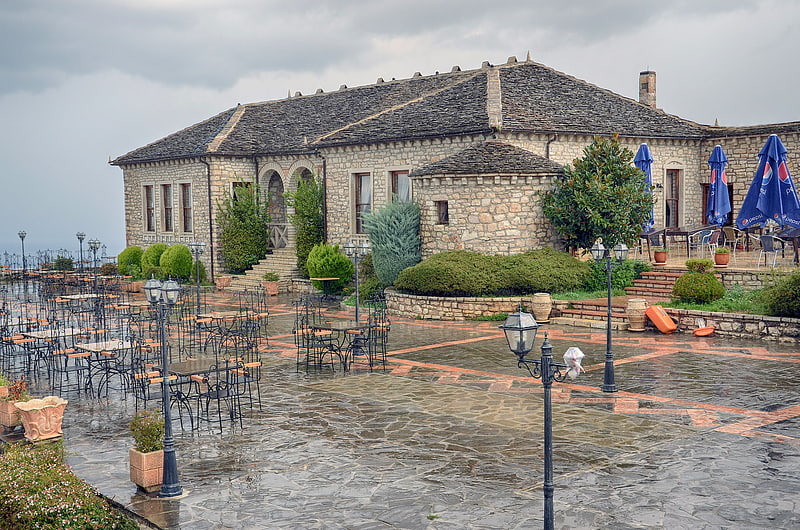
Also known as: Kalaja e Lëkurësit
Castle in Sarandë, Albania. Lëkurësi Castle is a ruined castle near Sarandë, southern Albania. The castle is on a strategic hill point overlooking the town of Sarandë, southeast of the town centre. From here one can control the whole town as well as the islands of Ksamil.[10]
Address: Kalaja e Lekuresit, Sarandë
Lead Mosque, Shkodra
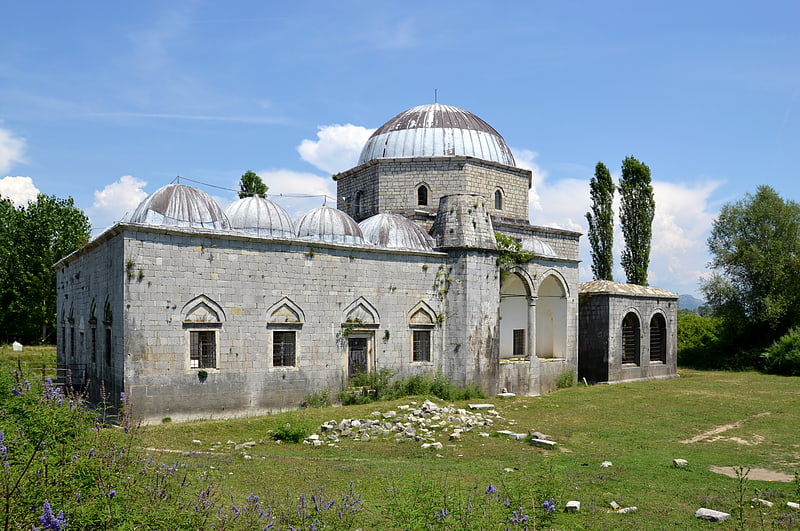
Also known as: Xhamia e Plumbit
Mosque. The Lead Mosque, also known as the Buşatlı Mehmet Pasha Mosque, is a historical mosque in Shkodër, northwestern Albania.
It took the name Lead Mosque, because all of its cupolas were covered with lead.[11]
Address: 1 Rruga Tabakeve, Shkodra
Aleksandër Moisiu Theatre, Durrës
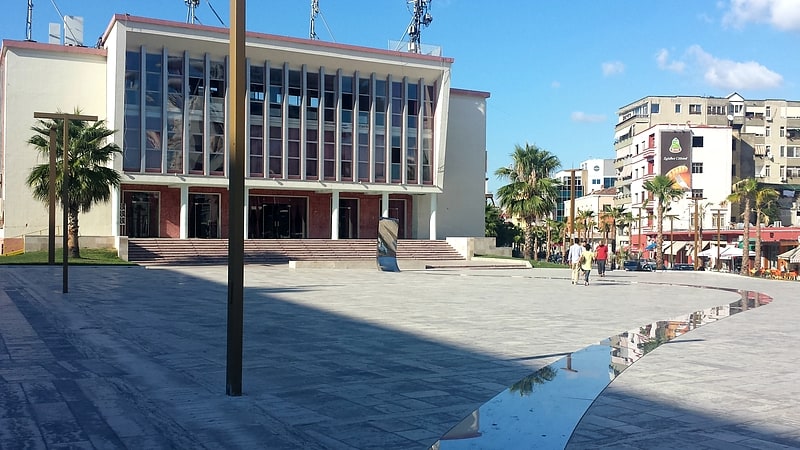
Also known as: Teatri Aleksandër Moisiu
Theatre in Durrës, Albania. The Aleksandër Moisiu Theatre, or called also Durrës Theatre is a theatre in the city centre of Durrës, Albania. The theatre took its name from Austrian actor Alexander Moissi, who was of Albanian descent.[12]
Address: Durrës, Lagja Nr: 2, Square Liria
Mes Bridge, Shkodra
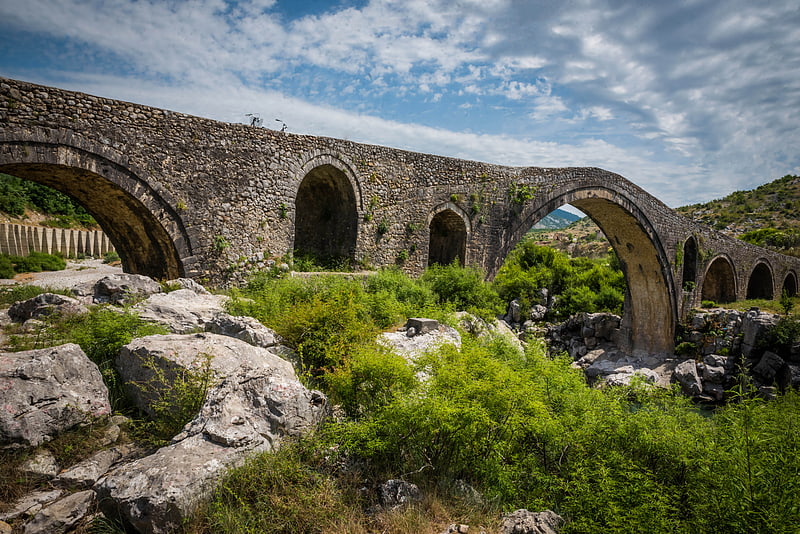
Also known as: Ura e Mesit
Bridge in Albania. Mesi Bridge is a bridge in the village of Mes, about 5 km northeast of Shkodër, in northwestern Albania. It is a monument of Postribë culture, turning the site into a tourist attraction with a lot of visitors from all around the world. For foreigners the architecture of the bridge is intriguing with round slick stones and stone plates. The surrounding panorama gives the bridge an even more picturesque view. The Albanian Development Fund invested 13 million lekë so the tourists could step on the bridge and watch it closely because there was no entry way to the bridge.
It was built in the 18th century, around 1770, by Kara Mahmud Bushati, the local Ottoman pasha, and spans the Kir River. The building was divided in 2 phases where the first phase was only the middle arc and the arc near it and the second phase included the other 11 arches. The purpose was to connect the city of Shkodër with the city of Drisht and other cities of the northern side. It is 108m long, 3.4 meters wide, 12.5 meters high with 13 arches, and is one of the longest examples of an Ottoman bridge in the region. It was built as part of the road that goes up the Kir Valley, eventually to Pristina.
Today the bridge is at risk, having been damaged over time by devastating floods, which have resulted in floodwaters cutting away at the arches on the right side, causing cracking.[13]
National Iconographic Museum Onufri, Berat
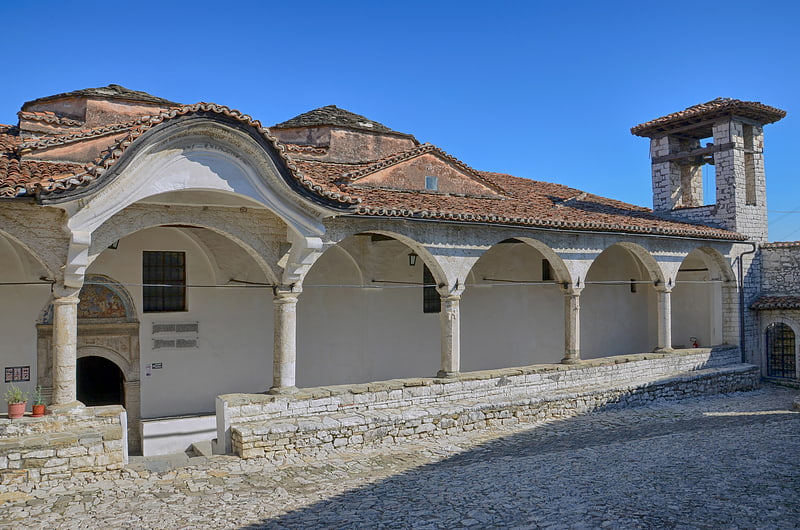
Also known as: Muzeu Ikonografik Onufri
Museum in Berat, Albania. The National Iconographic Museum "Onufri" is an Albanian national museum dedicated to Byzantine art and iconography in Berat, Albania. The museum is located inside the Church of the Dormition of St Mary in the castle quarter Berat. The museum was named to honor Onufri, a painting Headmaster of the 16th century.
The museum features on display 173 objects chosen among 1500 objects belonging to the found of Albanian Churches and Monasteries as well as to Berat.[14]
Address: Rrugica Shën Triadha, Berat
Zekate House, Gjirokastër
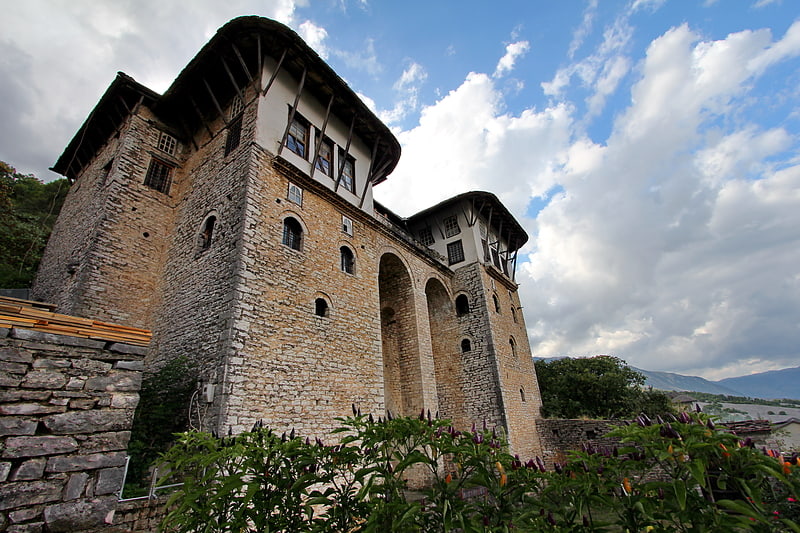
Also known as: Banesa Zapanaja e Zekatëve
Historical landmark in Gjirokastër, Albania. Zekate House, is a house in Gjirokastër, Albania. The house, built in 1812, is said to be "one of the grandest examples of Gjirokastër architecture in the Ottoman style".
Fortified tower houses, (known as kullë in Albanian), belonged to wealthy people, such as government officials or merchants. All rooms have a basic design: a safe ground floor with a wooden gallery on top, which are the most important rooms for an extended family. The decks are placed on the walls to help defend against the enemies they attack. Zekate's house is an example of an urban kullë. Built in 1811–1812, it has two towers and a large double arch facade. The panorama of the city can be viewed from the house.[15]
Address: Gjirokastra, short hike form main bazaar, Gjirokastër
Berat Castle, Berat
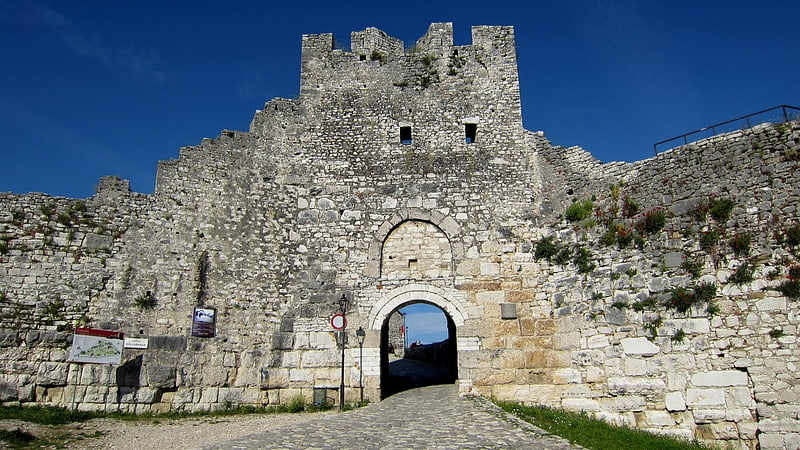
Also known as: Kalaja e Beratit
Remains of a large 13th-century fortress. Berat Castle, also referred to as the Citadel of Berat and castle quarter, is a fortress overlooking the town of Berat, Albania. It dates mainly from the 13th century and contains many Byzantine churches in the area and Ottoman mosques. It is built on a rocky hill on the left bank of the river Osum and is accessible only from the south. It is situated at an elevation of 214 metres.[16]
Teqe Mosque, Gjirokastër

Also known as: Xhamia e Teqesë
Mosque. The Teqe Mosque is a mosque in Gjirokastër, Albania. It is a Cultural Monument of Albania.
It was described by famed explorer Evliya Çelebi in the 17th century, but its current form is the work of an Ahmet Çelebi in 1773. A inscription dates it to 1732 to 1733 (Hijri year 1145). Though named Teqe by its first descriptor, the locals call it Mesh Mosque. Still standing in 1967 and originally slated for demolition soon after, it was reprieved with cultural monument status in 1973.[17]
Church of the Holy Trinity, Berat

Also known as: Kishat e Kalase: Godina e kishes se Shën Triadhës
The Holy Trinity Church is a medieval Byzantine church which stands on a hill in the city of Berat in the Kalaja district of Southern Albania.
One of the Historic Centres of Berat and Gjirokastër UNESCO World Heritage Site, the church has a cross shaped plan with a dome. It is composed of the nave, narthex (entrance area) and the altar alcove. In the church many Byzantine architecture features have been skilfully used such as the inner organization of the space and the decorative and illuminative systems. These features, together with the pyramidal shape, forms and proportions give the church a picturesque appearance. The Byzantine architectural elements in the church have been combined with western architectural elements belonging to the same period.
Inside the church are two columns with reused capitals (thought to have been taken from classical ruins in the city). An inscription inside the church contains the name of Andronicus Paleologus (Governor of the province of Berat from 1302 to 1326), indicating that the church must have been built during the 13th or 14th century with his financial support.[18]
Muradie Mosque, Vlorë

Also known as: Xhamia e Muradies
Mosque in Vlorë, Albania. The Muradie Mosque or Lead Mosque is a Cultural Monument of Albania, located in Vlorë. The mosque was built in 1537 by the famous Ottoman Turkish architect Mimar Sinan during the rulership of Sultan Suleiman the Magnificent. The construction was completed in 1542 AD.
The mosque is located in downtown Vlora on a central square, surrounded on all four sides with roads. It is located on west of Sadik Zotaj, south of Lef Sallata and east of Papa Kristo Negovani streets.
The structure consists of the main building and the minaret. The former is about 10 to 11 square meters while the minaret has a length of 18 metres. In the past, it also had a portico which has been destroyed later. The mosque has a dome with a supporting polygon raised base, arched windows and classical triangular forms topping the side walls. The brick work of the Muradie mosque has layers with two different brick colors. There is also a contrast between the texture, quality, color, as well as size and sequence of the bricks used to build the Islamic prayer hall compared with the larger white chiseled stones used to build the minaret.
It is believed that the cultural monument was designed by the prominent Albanian architect, Mimar Sinani, a leading mosque builder in the Ottoman Empire and the author of the Great Suleymaniye Mosque in Istanbul.[19]
Address: Rruga Ate Kristo Negovani cnr, Vlorë
Old Bazaar, Kruje
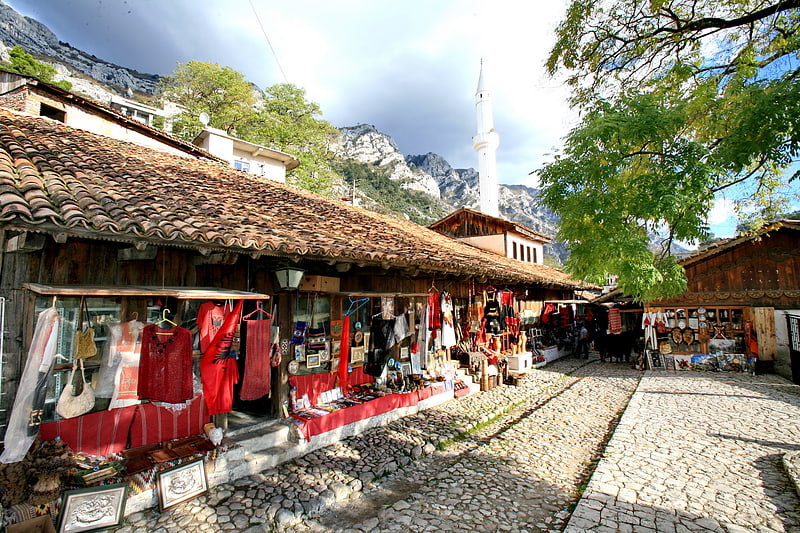
Also known as: Pazari i Vjetër
Bazaar, Shopping
Address: Rruga Albanopolis, Kruje
Bazaar Mosque, Kruje

Also known as: Xhamia e Pazarit
Mosque. The Bazaar Mosque, also known as Murad Bey mosque or Varosh mosque, is a historic mosque in Krujë, Albania. It was built in 1533 and is a Cultural Monument of Albania today. It is situated in the historic bazaar of Kruje, known as Akce Hisar in Ottoman times. Built by Ottoman Albanian beys, the mosque got closed during the Communist dictatorship and its typical minaret got torn down. The mosque was reopened in 1991.
During the renovation by the Turkish Cooperation and Coordination Agency (TIKA) in the 2010s, the antique ornate and interior painting of the Bazaar mosque got completely lost.[20]
Apollonia, Fier

Also known as: Apolonia
City. Apollonia was an Ancient Greek trade colony which developed into an independent polis, and later a Roman city in southern Illyria in classical antiquity. It was located on the right bank of the Aoös/Vjosë river, approximately 10 km from the eastern coast of the Adriatic Sea. Its ruins are situated in the county of Fier, close to the village of Pojan, in Albania.
Apollonia was founded around 600 BC by Ancient Greek colonists from Corinth and possibly Corcyra as a trading settlement after an invitation by local Illyrians on a largely abandoned coastal site. It was perhaps the most important of the several classical towns known as Apollonia. Corinthian colonial policy seems to have been relatively liberal, and was more focused towards resource extraction so as to support the growing Corinthian population, rather than exploitation or expulsion of the local Illyrian population. Apollonia gradually gained political independence from Corinth and was organized as a polis under an oligarchic system. According to Aristotle, In Apollonia's oligarchy, a small Greek elite class largely descended from the original colonists ruled over a largely local Illyrian population.
Apollonia flourished in the Roman period. From the 2nd century BC it became an important military staging ground for the Roman armies. It was home to a renowned school of philosophy, acquiring fame as a cultural center, and by the end of the Republican period it became a major center of Greek learning. The reputation of Apollonia attracted many brilliant students from different parts of the empire, including Augustus, the first Roman emperor. The city began to decline in the 3rd century AD when its harbor started silting up as a result of an earthquake. It was abandoned in the 4th century AD.
The name of the city is mentioned among the modern bishoprics of the Orthodox Autocephalous Church of Albania (Apollonia and Fier). Apollonia is also a titular see of the Latin Church. The ruins were designated as an archaeological park on 7 April 2003 by the government of Albania.[21]
Pasqyra Beach, Sarandë
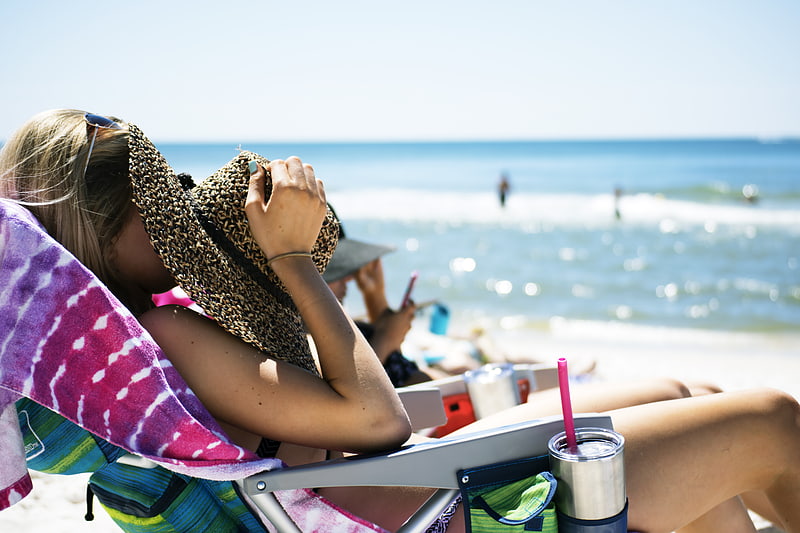
Beach, Outdoor activities, Park
Independence Monument, Vlorë
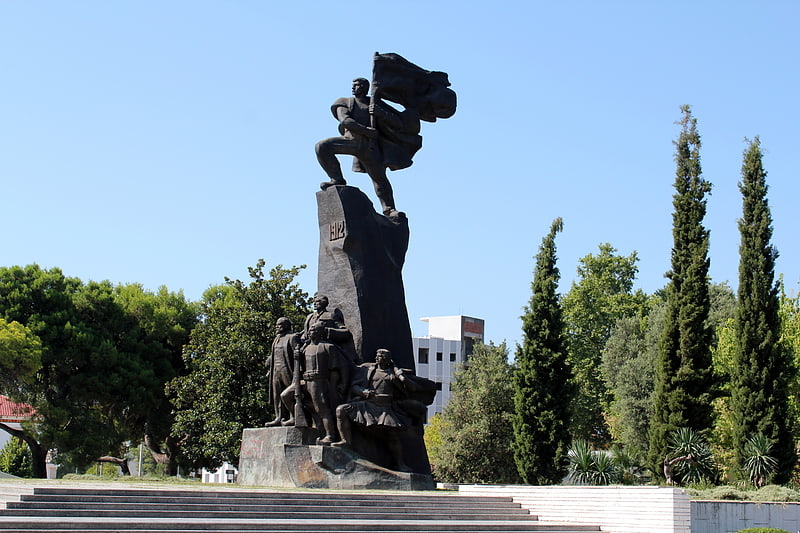
Also known as: Monumenti i Pavarësisë
Tourist attraction in Vlorë, Albania. The Monument of Independence is a monument in Vlorë, Albania, dedicated to the Albanian Declaration of Independence and worked by Albanian sculptors, Muntaz Dhrami and Kristaq Rama. It is found in the Flag's Plaza, near the building where the first Albanian government worked in 1913.
In the center of the monument is the sculpture of Ismail Qemali, the leader of the Albanian national movement and founder of Independent Albania.[22]
National Museum of Medieval Art, Korçë
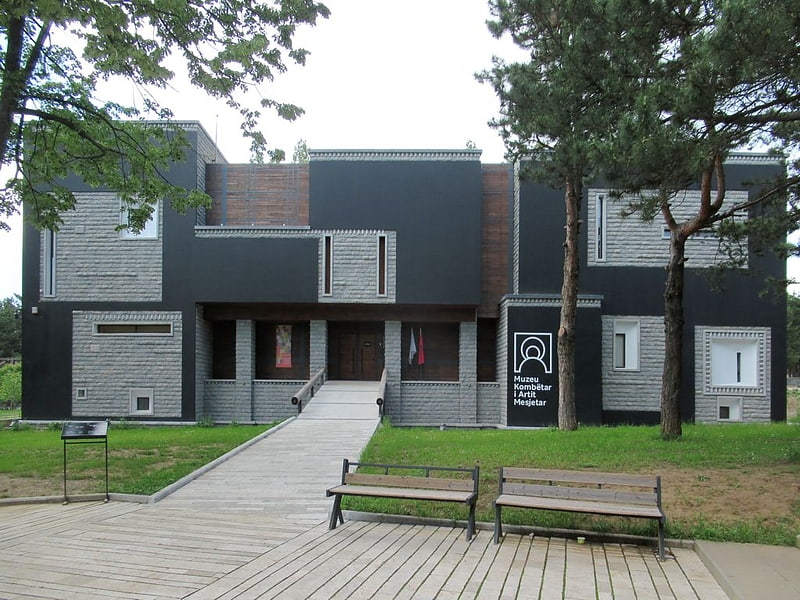
Also known as: Muzeu Kombëtar i Artit mesjetar Korçë
Museum in Korçë, Albania. The National Museum of Medieval Art is a national museum dedicated to medieval art and history in Korçë, Albania. The museum is located on Fan Noli Boulevard in the south-east of the city of Korçë. It was established on April 24, 1980, and the building was reconstructed on October 4, 2016, with the cooperation of the city municipality and the Greek Government fund.
The museum has over 7,000 art and cultural items, mainly icons, stone, wooden, metal and textile works, representing various moments in Albania's iconography development. In the principal hall there are many works from anonymous artists of the 13th-14th centuries and well-known ones including Onufri, Onufër Qiprioti, Teacher Kostandini, Jeromak Shpataraku, David Selenica, and the Zografi Brothers.
Due to the COVID-19 lockdown in Albania, the Ministry of Culture offers 3D tours of the museum.[23]
Address: Rruga Mihal Grameno, Korçë